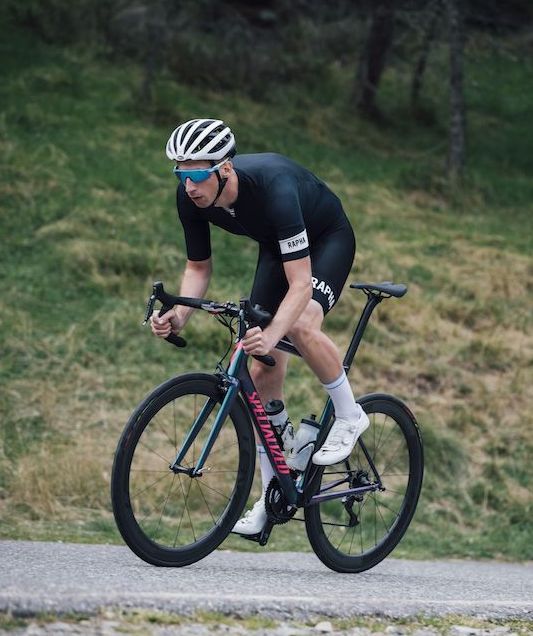How do I calculate my body fat?
Too much body fat is bad news for health and performance, so what’s the right amount? Laura Tilt, investigates


When it comes to body fat, less is generally better. Carrying too much fat increases the risk of heart disease and Type 2 diabetes and weighs you down without contributing to forward motion.
In a 2011 study from the Department of Exercise Science at Washington University, scientists examined the threshold at which simulated gains in body fat affected performance.
Extra weight (equivalent to two, four, six, eight and 10 per cent of body weight) was added to the upper body of adults during fitness testing.
Across every test, performance started to decrease after just a two per cent increase in weight.
The message is clear: “Reducing body fat is one of the easiest ways to improve watts generated per kilogram of body mass, i.e. performance,” says Dr Ian Rollo, principal scientist at the Gatorade Sports Science Institute.
Watch now: How to burn fat through cycling
Body fat is divided into essential and storage fat. Essential fat is the minimum level needed for the body to function normally.
The latest race content, interviews, features, reviews and expert buying guides, direct to your inbox!
>>> High fat foods that are good for you (video)
This is typically three per cent for men and 12 per cent for women — but such levels are rarely reached even by the skinniest pro climbers.
Storage fat is everything over and above this level.
So, what’s a healthy level of body fat for a cyclist?

According to Philip Chant, director of Bodyscan, which offers body fat measurement via DEXA scan,
“A keen, seasoned [male] cyclist would want to have around 15.5 per cent; 22 per cent for women.”
>>> Which foods boost weight loss?
The healthy range recommended to the general population is 10-22 per cent for men and 20-32 per cent for women.
The accuracy of measuring body fat varies between the different techniques used.
At present, DEXA (dual-energy X-ray absorptiometry) scans are regarded as the gold standard.
Initially developed for measuring bone density, DEXA provides precise measurements of fat-free mass and fat mass, and is popular in professional sport.
“DEXA provides data for arms, legs and trunk, rather than a single, overall number,” says Chant.
“It does that not just for fat but for lean mass too. This means we can get a clear picture of fat and muscle distribution.”
>>> Strength training for cyclists: Is it worth it?
Measuring body fat: what's the best method?
When it comes to measuring body fat, not all techniques are equal.
The key is expert measurement. “The main point, independent of method used, is to ensure body fat measurement is completed by a suitably qualified individual and standardisation is completed prior to assessment, so meaningful changes can be tracked over time,” says Dr Rollo.
| BMI Body mass index | Easily calculated; anyone can do it | Does not distinguish between fat and non-fat mass | £0 | Poor; misleading for muscular people |
| BIA Bio Impedance Analysis, via electric current. | Cheap to perform, widely available in home scales e.g. Tanita | Hydration level and skin temperature can skew results | Scales with BIA ~ £40 | Anywhere from 2-28% |
| Skinfold thickness Calipers used to measure skinfolds | If done correctly by a trained individual, can be precise | Imprecise application leads to inaccurate results; requires ISAK-trained tester | £50 | Within 3-10% |
| DEXA Dual-energy X-ray absorptiometry | Often described as the “gold standard”; detailed results | Expensive | £150 | Within 2-5% |
| Bod Pod Air Displacement Plethysmography (ADP) | Rapid and reliable | Doesn’t show distribution of body fat | £49 | Within 1-2% |
Is there such a thing as ideal body fat for a cyclist?
According to Dr Rollo, principal scientist at the Gatorade Sports Science Institute, there’s no one-size-fit-all prescription for body fat.
“Each cyclist an optimal level of body fat. However, above-normal percentages are not conducive to cycling performance.
"If you’re trying to lose weight, it’s interesting to map body fat values against watts per kilogram or TT performance.”
Remember, there is minimal, essential level of body fat required for health.
“Keep a note on your ability to maintain training intensities and general mood,” recommends Rollo.
“Sustaining low body fat may increase your susceptibility to illness and fatigue and decrease general motivation towards training.”
Follow on Twitter: @richwindy
Richard is digital editor of Cycling Weekly. Joining the team in 2013, Richard became editor of the website in 2014 and coordinates site content and strategy, leading the news team in coverage of the world's biggest races and working with the tech editor to deliver comprehensive buying guides, reviews, and the latest product news.
An occasional racer, Richard spends most of his time preparing for long-distance touring rides these days, or getting out to the Surrey Hills on the weekend on his Specialized Tarmac SL6 (with an obligatory pub stop of course).
